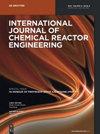Influence of different influence parameters on mixing characteristics of silicon particles in cassette
IF 1.6
4区 工程技术
Q3 Chemical Engineering
International Journal of Chemical Reactor Engineering
Pub Date : 2023-08-04
DOI:10.1515/ijcre-2022-0217
引用次数: 0
Abstract
Abstract The numerical simulation length of the cassette model is determined by studying the effects of the cassette frame rotated alone and the rotated together with the agitator on mixing under different cassette lengths. The effects of different rotating speed, filling ratio of silicon particles, shape and number of agitators on the mixing characteristics of silicon particles in the cassette are studied when the outer frame of the cassette rotated alone and the cassette rotated together with the agitator. The mixing degree is quantitatively analyzed by particle trajectory, mixing index and rate, and the optimum working conditions of each influencing parameter are obtained. The results show that considering the computation time and the influence of the two motion modes on the mixing index and rate, the numerical simulation length of the cassette model is 115 mm. In order to obtain the best mixing effect and mixing speed, it is recommended that the rotating speed of the cassette is 8.91 rad/s, the filling rate is 23.60 %, and the shape of the agitator is rectangular and the number is 6. When the cassette and agitator rotate together, the filling rate has little effect on particle mixing. Considering the production efficiency, mixing effect and rate, as well as the stability of mixing, the recommended speed is 4.08 rad/s, the filling rate is 41.40 %, and the rectangular shape and number of six agitators are ideal choices.不同影响参数对硅颗粒在盒内混合特性的影响
摘要通过研究不同盒体长度下单独旋转盒体和与搅拌器共同旋转盒体对混合的影响,确定了盒体模型的数值模拟长度。在盒式外框单独旋转和盒式与搅拌器共同旋转的情况下,研究了不同转速、硅颗粒填充比、搅拌器形状和数量对盒式硅颗粒混合特性的影响。通过颗粒轨迹、混合指数和混合速率对混合程度进行定量分析,得出各影响参数的最佳工作条件。结果表明:考虑计算时间和两种运动方式对混合指数和混合速率的影响,盒式模型的数值模拟长度为115 mm。为了获得最佳的搅拌效果和搅拌速度,建议箱体转速为8.91 rad/s,填充率为23.60 %,搅拌器形状为矩形,数量为6个。当箱体与搅拌器同时旋转时,填充率对颗粒混合的影响不大。综合考虑生产效率、混合效果和混合速率以及混合的稳定性,推荐速度为4.08 rad/s,填充率为41.40 %,矩形形状和6台搅拌器的数量是理想的选择。
本文章由计算机程序翻译,如有差异,请以英文原文为准。
求助全文
约1分钟内获得全文
求助全文
来源期刊
CiteScore
2.80
自引率
12.50%
发文量
107
审稿时长
3 months
期刊介绍:
The International Journal of Chemical Reactor Engineering covers the broad fields of theoretical and applied reactor engineering. The IJCRE covers topics drawn from the substantial areas of overlap between catalysis, reaction and reactor engineering. The journal is presently edited by Hugo de Lasa and Charles Xu, counting with an impressive list of Editorial Board leading specialists in chemical reactor engineering. Authors include notable international professors and R&D industry leaders.

 求助内容:
求助内容: 应助结果提醒方式:
应助结果提醒方式:


